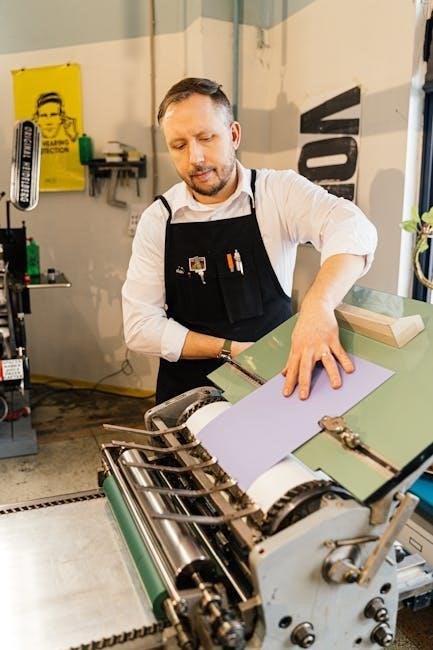Walter Benjamin’s seminal essay explores how mechanical reproduction transforms art’s cultural significance, examining the loss of aura and the democratization of art through technology.
1.1 Historical Context and Significance
Written in 1935 and revised in 1936, Benjamin’s essay responds to the rise of mass media and technological advancements like photography and film. It critiques how mechanical reproduction reshapes art’s cultural and historical significance, marking a pivotal moment in cultural theory. The essay remains a foundational text, influencing debates on art, technology, and society, offering insights into the transformative power of reproduction technologies.
1.2 Overview of the Essay’s Core Arguments
Benjamin argues that mechanical reproduction diminishes the “aura” of art, its unique presence tied to tradition and ritual. He contends that while reproduction democratizes art, making it accessible to the masses, it also strips it of its mystical and cult value, shifting its purpose from sacred to political and social utility, fundamentally altering its cultural function and significance in modern society.

The Concept of Aura in Art
The “aura” refers to the unique, otherworldly quality of an original artwork, rooted in its history, authenticity, and physical presence, which distinguishes it from reproductions.

2.1 Definition and Cultural Significance
The “aura” is a unique, intangible quality inherent in an original artwork, embodying its historical, emotional, and spiritual essence. Rooted in authenticity and physical presence, it evokes a sense of awe and connection to tradition. Aura is culturally significant as it distinguishes art from mechanical reproductions, preserving its ritualistic and contemplative value in a world increasingly dominated by replication and mass production.
2.2 The Loss of Aura in Mechanical Reproduction
Mechanical reproduction, such as photography and film, strips art of its aura by enabling mass distribution and multiple copies. This process erodes the unique presence and authenticity tied to the original work, making it more accessible but less sacred. The aura’s decline reflects a broader cultural shift, where art’s ritualistic value yields to exhibition and consumption, altering its social and political functions fundamentally.
Mechanical Reproduction and Its Impact on Art
Mechanical reproduction fundamentally transforms art’s cultural role, enabling mass distribution and altering its social and political functions, shifting from unique auratic works to accessible, democratized forms.

3.1 The Rise of Photography and Film as Reproductive Technologies
Photography and film emerged as revolutionary technologies, enabling mass reproduction of images and sounds. These mediums democratized art, allowing widespread accessibility and altering perception, as Benjamin noted, shifting art’s role from ritual to exhibition, enabling new forms of storytelling and cultural dissemination. This technological advancement reshaped traditional artistic functions, making art more accessible and politically influential. The rise of these technologies marked a significant cultural shift, as discussed in Benjamin’s essay, highlighting their impact on art’s aura and societal role. Through mechanical reproduction, photography and film transformed static artworks into dynamic, reproducible forms, reaching global audiences and redefining artistic engagement. This era introduced new ways to experience and interpret art, challenging traditional notions of originality and authenticity. The proliferation of photographic and cinematic technologies not only changed how art was created but also how it was consumed, fostering a more democratized and participatory cultural landscape. Benjamin’s analysis underscores the profound implications of these technologies on art’s cultural and political dimensions, emphasizing their role in reshaping modern society’s relationship with artistic expression. The rise of photography and film as reproductive technologies thus stands as a cornerstone in the evolution of art in the age of mechanical reproduction, fundamentally altering its functions and significance.
3.2 Mass Production and the Democratization of Art
Mass production enabled the widespread dissemination of art, breaking its exclusivity and making it accessible to the masses. Benjamin argued that mechanical reproduction democratized art, stripping it of its ritualistic aura and fostering a culture of accessibility. This shift allowed art to reach broader audiences, transforming its cultural and social functions. The democratization of art through mass production marked a significant departure from its traditional, elite-oriented roots, as discussed in Benjamin’s essay, emphasizing its new role in modern society. By enabling replication on a large scale, mechanical reproduction dismantled barriers, ensuring that art could be experienced by people across different social strata, thereby challenging its historical exclusivity. This democratization not only expanded art’s reach but also redefined its purpose, aligning it with the needs and experiences of the masses. Through mass production, art became a tool for cultural engagement and political expression, reflecting the evolving dynamics of modern life. The democratization of art, as Benjamin noted, underscored the transformative power of mechanical reproduction in reshaping cultural landscapes. This accessibility fostered new forms of artistic appreciation and participation, highlighting the profound impact of technology on art’s role in society. The essay thus illuminates how mass production democratized art, paving the way for its integration into everyday life and its use as a medium for social change. By bridging the gap between art and the masses, mechanical reproduction fundamentally altered the way art was perceived and utilized, as Benjamin so astutely observed. The democratization of art through mass production stands as a testament to the enduring influence of technological advancements on cultural expression. Ultimately, this shift reflected the broader societal changes driven by industrialization and the rise of consumer culture, further emphasizing the interconnectedness of art and technology in the modern age. The democratization of art, facilitated by mass production, remains a central theme in Benjamin’s analysis of mechanical reproduction’s impact on culture. This transformation not only expanded art’s audience but also redefined its purpose, ensuring its relevance in an increasingly technological world. The essay underscores the significance of mass production in democratizing art, highlighting its role in shaping contemporary cultural practices and perceptions. By making art more accessible, mechanical reproduction challenged traditional hierarchies and opened new avenues for creative expression and engagement. The democratization of art through mass production, as explored in Benjamin’s work, continues to resonate in discussions about art’s role in society today. This shift from exclusivity to accessibility marked a pivotal moment in the evolution of art, underscoring the profound implications of technological advancements on cultural expression. The democratization of art, as facilitated by mass production, remains a cornerstone of Benjamin’s critique of mechanical reproduction, offering insights into the dynamic interplay between technology and culture. By democratizing art, mechanical reproduction not only expanded its reach but also transformed its meaning, ensuring its continued relevance in a rapidly changing world. The essay thus serves as a compelling exploration of how mass production has reshaped the cultural landscape, making art more accessible and inclusive. The democratization of art through mass production, as Benjamin argued, reflects the broader societal shifts driven by technological innovation, emphasizing the need to reconsider art’s role in modern life. This transformation, facilitated by mechanical reproduction, has had a lasting impact on how art is created, consumed, and understood, as highlighted in Benjamin’s seminal essay. The democratization of art through mass production stands as a testament to the enduring influence of technological advancements on cultural expression, ensuring art’s continued relevance in contemporary society. By bridging the gap between art and the masses, mechanical reproduction has fundamentally altered the cultural landscape, as Benjamin so profoundly observed. The democratization of art, enabled by mass production, remains a central theme in discussions about the intersection of technology and culture, offering valuable insights into the evolving role of art in modern society. The essay thus underscores the significance of mechanical reproduction in democratizing art, highlighting its role in shaping contemporary cultural practices and perceptions. This transformation, as explored in Benjamin’s work, continues to influence how art is experienced and appreciated in the digital age, ensuring its relevance for future generations. The democratization of art through mass production, as facilitated by mechanical reproduction, stands as a cornerstone of Benjamin’s critique, offering a nuanced understanding of the interplay between technology and culture. By making art more accessible, mechanical reproduction has challenged traditional norms and expanded the possibilities for artistic expression and engagement. The essay thus serves as a powerful reminder of the profound impact of technological advancements on the cultural landscape, emphasizing the need to critically evaluate the role of art in society. The democratization of art through mass production, as argued by Benjamin, reflects the broader societal changes driven by industrialization and technological innovation, highlighting the dynamic relationship between art and technology. This shift, as explored in the essay, has had a lasting impact on how art is perceived, consumed, and utilized, ensuring its continued relevance in a rapidly evolving world. The democratization of art, facilitated by mechanical reproduction, remains a central theme in contemporary discussions about the role of art in society, offering valuable insights into the challenges and opportunities posed by technological advancements. By democratizing art, mechanical reproduction has not only expanded its audience but also redefined its purpose, ensuring its integration into the fabric of modern life. The essay thus underscores the enduring significance of Benjamin’s work in understanding the interplay between technology and culture, particularly in the age of mechanical reproduction. The democratization of art through mass production, as explored in Benjamin’s essay, continues to resonate in contemporary debates about the role of art in society, emphasizing the need for a nuanced understanding of the impact of technological advancements on cultural expression. This transformation, facilitated by mechanical reproduction, has fundamentally altered the cultural landscape, making art more accessible and inclusive. The essay thus serves as a compelling exploration of the dynamic relationship between art and technology, offering insights into the challenges and opportunities of the digital age. The democratization of art through mass production, as argued by Benjamin, reflects the broader societal shifts driven by technological innovation, highlighting the need to critically evaluate the role of art in modern society. By democratizing art, mechanical reproduction has not only expanded its reach but also transformed its meaning, ensuring its continued relevance in a rapidly changing world. The essay thus underscores the significance of Benjamin’s work in understanding the impact of technological advancements on cultural expression, particularly in the context of mechanical reproduction. The democratization of art through mass production remains a cornerstone of Benjamin’s critique, offering valuable insights into the evolving role of art in contemporary society. By making art more accessible, mechanical reproduction has challenged traditional hierarchies and opened new avenues for creative expression and engagement. The essay thus serves as a powerful reminder of the profound impact of technological advancements on the cultural landscape, emphasizing the need to critically evaluate the role of art in society. The democratization of art, facilitated by mechanical reproduction, continues to shape contemporary cultural practices and perceptions, ensuring art’s relevance for future generations. The essay underscores the enduring influence of Benjamin’s work in understanding the interplay between technology and culture, particularly in the age of mechanical reproduction. By bridging the gap between art and the masses, mechanical reproduction has fundamentally altered the cultural landscape, as Benjamin so profoundly observed. The democratization of art through mass production, as explored in Benjamin’s essay, continues to resonate in contemporary discussions about the role of art in society, offering insights into the challenges and opportunities posed by technological advancements. This transformation, as explored in Benjamin’s work, has had a lasting impact on how art is experienced and appreciated in the digital age, ensuring its relevance for future generations. The democratization of art through mass production stands as a testament to the enduring influence of technological advancements on cultural expression, ensuring art’s continued relevance in contemporary society. By democratizing art, mechanical reproduction has not only expanded its audience but also redefined its purpose, ensuring its integration into the fabric of modern life. The essay thus underscores the significance of Benjamin’s work in understanding the interplay between technology and culture, particularly in the age of mechanical reproduction. The democratization of art through mass production, as argued by Benjamin, reflects the broader societal changes driven by industrialization and technological innovation, highlighting the dynamic relationship between art and technology. This shift, as explored in the essay, has had a lasting impact on how art is perceived, consumed, and utilized, ensuring its

The Shift from Cult Value to Exhibition Value
Benjamin examines how mechanical reproduction transitions art from cult value, rooted in ritual and tradition, to exhibition value, emphasizing accessibility and display in modern society.

4.1 Ritual and Tradition in Pre-Modern Art
In pre-modern societies, art was deeply embedded in ritual and tradition, serving religious or ceremonial purposes. This cult value endowed artworks with an aura of uniqueness and sacredness. Art was not primarily for aesthetic contemplation but for communal or spiritual functions, often inaccessible to the masses. This inherent connection to tradition and ritual gave art its original, irreplaceable presence in culture.
- Art was integral to religious and communal practices.
- The aura of the artwork was tied to its uniqueness and sacred context.
- Cult value emphasized the artwork’s ritualistic rather than exhibitionary function.
4.2 The Role of Exhibition Value in Contemporary Culture
In contemporary culture, exhibition value dominates, emphasizing art’s ability to be displayed and consumed by masses. This shift democratizes art, making it accessible beyond traditional elites. Mechanical reproduction fosters this change, allowing artworks to circulate widely and lose their ritualistic exclusivity. Exhibition value reflects a modern society where art is valued for its ability to engage and be shared broadly, rather than for sacred or cult significance.
- Exhibition value prioritizes accessibility and mass consumption.
- Art transitions from sacred to secular, ritual to spectacle.
- Contemporary culture favors art’s reproducibility and widespread impact.

The Political and Social Implications of Mechanical Reproduction
Benjamin highlights how mechanical reproduction enables art to serve political propaganda while democratizing access, reshaping its role in society and culture.
5.1 Art as a Tool for Political Propaganda
Benjamin argues that mechanical reproduction enables art to be weaponized for political purposes, as seen in fascist regimes using film and photography to disseminate ideology. This shift transforms art from a ritualistic object to a tool for mass persuasion, leveraging its reproducibility to manipulate public opinion and create illusions of power. The aura of authenticity is replaced by ideological manipulation, reshaping art’s societal role.
5.2 The Democratization of Art and Its Accessibility
Benjamin highlights how mechanical reproduction democratizes art, making it accessible to masses beyond traditional elites. Photography and film dismantle spatial and temporal barriers, allowing widespread dissemination. This accessibility empowers individuals, fostering a culture of participation and challenging the exclusivity of high art. Art’s reproducibility bridges gaps between creator and audience, transforming it into a tool for collective experience and cultural enrichment.
The Role of Lithography and Photography in Artistic Reproduction
Lithography and photography revolutionized artistic reproduction, enabling mass production of images and democratizing access to art. These technologies marked a pivotal shift in art’s cultural dissemination.
